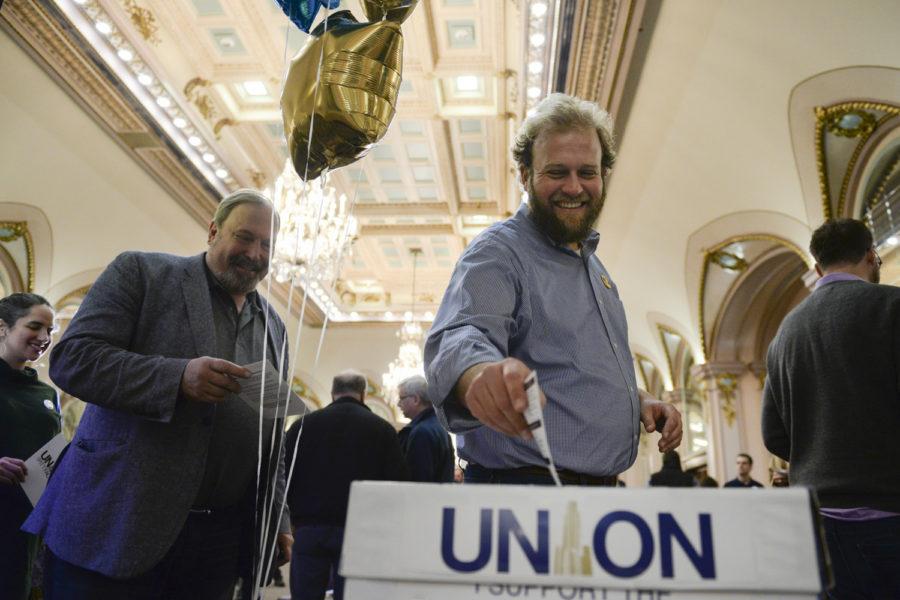Explainer: How to vote in Pitt’s faculty union election


Tyler Bickford, a professor in the English department, drops one of the first union cards at a kickoff event held by Pitt faculty union organizers in the William Pitt Union Ballroom in January 2018.
A multi-year effort to unionize roughly 3,000 University faculty will culminate in a union election starting Friday. Pitt professors and researchers from all campuses will be able to cast their votes between Aug. 27 and Oct. 12 to decide whether or not to form a faculty union.
Here is a guide to help faculty navigate the upcoming union election:
How do I vote?
The Pennsylvania Labor Relations Board, which presides over mostly public sector union elections in Pennsylvania, will mail every union-eligible faculty member a ballot with exact instructions on Friday. Faculty should receive their ballots at their home address sometime the following week.
Before ballots are mailed out on Friday, faculty should check to make sure the address they have on file with the University is accurate. To do this, faculty can go into PittWorx through the MyPitt portal. If the listed address is accurate, and has been in the system since May, the ballot should arrive at the right place, union organizers said. If not, faculty will have to request a duplicate ballot — more on that in the next section.
Each ballot will come in a secure envelope, along with detailed instructions on how to submit the ballot and two other envelopes that faculty can use to mail their ballot back to the PLRB, according to the PLRB’s order and notice of election, which was emailed to all union-eligible faculty earlier this year.
The ballot itself has two squares that faculty can mark.
To vote in favor of unionization, faculty should put an X in the square next to “United Steelworkers.” The Steelworkers have assisted Pitt’s unionization attempt since 2016, and if faculty vote in favor of unionization, the union would be affiliated with the Steelworkers’ Academic Workers Association.
To vote against unionization, faculty should put an X in the square next to “No Representative.”
According to PLRB instructions, faculty should not sign the ballot or mark it in any other way — doing so could void their vote.
Faculty should then put their ballots in the blank envelope they received, seal it, put the blank envelope inside the other envelope pre-addressed to the PLRB and seal it. No stamp is required to mail the ballot.
The PLRB must receive your ballot by Oct. 12 at 5 p.m. If your ballot arrives after Oct. 12 — even if it’s postmarked on or before Oct. 12 — it will not count. Union organizers are advising faculty to mail their ballots by Oct. 5 to ensure that all of them arrive before the deadline.
The PLRB will begin counting ballots on Oct. 19 at 10 a.m. at its Harrisburg headquarters.
What if I didn’t receive a ballot or I lost my ballot?
There are several reasons why a faculty member might not receive a ballot — they have the wrong address on file, they aren’t eligible to vote in the election or the ballot got lost in the mail.
If a faculty member has lost their ballot or has not received one in the mail by Sept. 13, they can ask the PLRB for a duplicate ballot by emailing katowens@pa.gov. The email should include the faculty member’s typed full name, mailing address, job title, reason for request and name of employer (University of Pittsburgh).
Organizers especially encourage faculty on the union-eligibility list to request a duplicate ballot if they didn’t already receive one, because their vote is guaranteed to count in the election.
Individuals not on the eligibility list can also request a duplicate ballot, but their votes will go into the challenge ballot pile. Challenge ballots won’t be opened unless there are enough of them to potentially alter the outcome of the election.
What changes are union organizers advocating for?
Union organizers have had three main priorities since kicking off their campaign in 2016 — improving pay, job security and transparency between the administration and faculty.
Those issues have become magnified in the past year. Questions about safety and shared governance emerged during the COVID-19 pandemic. Pitt froze salaries last year and instituted a 1.25% progressive pay raise in this year’s budget, which some faculty criticized as too meager.
A union, organizers say, will give faculty a seat at the table to help make decisions at Pitt.
“The presence of the union gives the faculty voice more power, wherever it is heard,” the faculty organizing website says.
The University’s administration did not explicitly come out against faculty unionization, but Provost Ann Cudd said in September 2018 that she was “not really clear what the need would be,” and Chancellor Patrick Gallagher said a few weeks later that “sometimes unions don’t always represent everyone equally well.”
Pitt spokesperson Kevin Zwick said last Friday that the University maintains that voting yes or no on unionization is “a decision for faculty members to make.”
“This is a consequential choice, and while the University has no position on what the outcome should be, we encourage voters to consider the matter seriously and to participate,” Zwick said. He pointed faculty to Pitt’s website on faculty unionization.
What will happen immediately after the election if faculty vote in favor of unionization?
If faculty vote “yes” on a union, the first step would be to elect a bargaining committee, with representatives from every University department — aside from the School of Medicine, which is excluded from the union — who could negotiate with the administration. Organizers said the committee should be diverse — with tenured and non-tenured professors and faculty from all campuses represented.
Those representatives would then ask other faculty in their departments about their main priorities for improving working life at Pitt and try to incorporate everyone’s suggestions and grievances in negotiations with the administration.
Sarah Leavens, a lecturer in the English department and a faculty union organizer, said organizers would make sure to reach out to faculty who voted against unionization.
“We want to find out how we can make it work for them — make it inclusive,” Leavens said. “You’re not voting on a platform … You’re voting on a process.”
After negotiations, faculty representatives and the administration would reach a tentative contract — which often includes a pay raise, a benefits package and worker protections — that faculty would once again have to vote on.
If a majority of faculty vote “yes” on the contract, it would become official. If faculty vote “no,” it would go back to the bargaining table.
How much would I have to pay in union dues?
Pitt faculty would pay United Steelworkers’ standard dues — 1.45% of each member’s gross monthly earnings plus $0.02 per hour. Part-time faculty compensated by the credit hour would pay 1.5%, without the hourly component.
Faculty would only be required to pay dues once the union ratifies a contract, which faculty must vote to approve. In nearly all cases, the pay raise for workers negotiated in their union contract exceeds the cost of dues.
What is the history of the faculty union campaign?
The faculty union effort officially began in January 2016, when Pitt’s organizers partnered with Steelworkers to launch their campaign, but organizing began in earnest several years before Steelworkers joined the cause. Pitt faculty union organizers have spent many years knocking on doors and pulling aside coworkers to discuss the union question.
That grassroots effort culminated in organizers filing for union election in January 2019 after saying they collected signed authorization cards from the requisite 30% of Pitt faculty. But the PLRB ruled in April 2019 that organizers had not collected enough signed authorization cards to trigger an election, which led to several rounds of hearings and legal disputes meant to determine who was eligible to vote in a faculty union election.
Financial disclosure reports obtained by The Pitt News show that Pitt has paid more than $2.1 million to Ballard Spahr, a Philadelphia-based “union avoidance” law firm, to provide legal support during the faculty union campaign and a separate unionization campaign by graduate students.
A Pitt News investigation found that Pitt had included hundreds of administrators and retired professors on its list of union-eligible faculty, which is used to determine whether the 30% threshold has been met. PLRB hearing examiner Stephen Helmerich ruled in June 2020 that the Pitt-submitted list was “factually and legally inaccurate.”
Helmerich finalized the list of union-eligible faculty in April, which paved the way for the PLRB to announce the union election in July.
Leavens, who’s been campaigning for a faculty union since 2014, said the upcoming election is “super exciting.”
“It takes a long time to have 3,000-plus conversations,” she said.
If you have any story ideas relating to faculty unionization, you can email the TPN News Desk at news@pittnews.com.
Recent Posts
Notes From an Average Girl // Notes on Book Banning
In this edition of Notes From an Average Girl, senior staff writer Madeline Milchman writes…
To Be Honest // Yup, it is that damn phone
In this edition of To Be Honest, staff writer Evin Verbrugge writes about her phone…
Meaning at the Movies | Portraying Toxic ‘Adolescence’
In this edition of Meaning at the Movies, staff writer Lauren Deaton explores the mini-series…
Opinion | Climate change requires radical, immediate action
Contributing editor Emma Hannan talks about the effects of climate change and the actions cities…
Jaland Lowe enters transfer portal, becomes fifth Panther to jump ship
On Tuesday morning, it was announced on X that Pitt sophomore guard Jaland Lowe was…
College Democrats and Republicans debate pressing political topics
Around 100 students gathered to watch Pitt’s College Democrats and College Republicans debate a variety…

